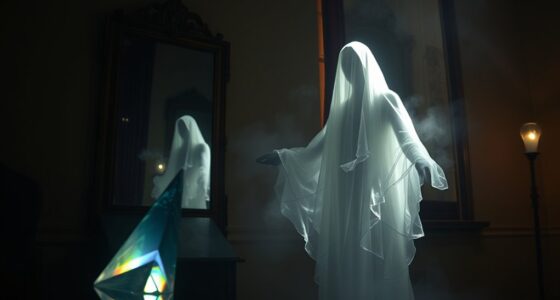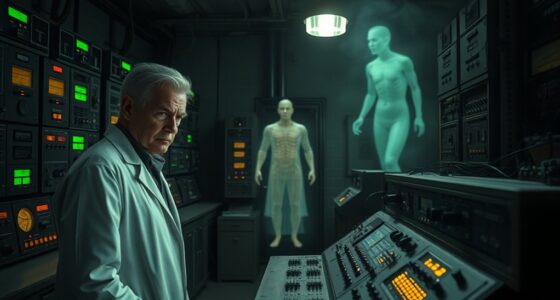EMF meters and spirit boxes are often claimed to detect spirits, but they are unreliable tools. EMF meters measure electromagnetic fluctuations, which can be caused by electrical devices or environmental factors, not necessarily spirits. Spirit boxes produce random radio noises that are easily misinterpreted as messages. Scientists and experts warn that these gadgets often give false positives and lack valid proof. If you want to uncover the truth about these devices, keep exploring what science has to say.
Key Takeaways
- EMF meters measure electromagnetic fluctuations, but environmental factors often cause false positives, not confirmed paranormal activity.
- Spirit boxes produce random radio snippets, with perception influenced by bias and interference, lacking scientific validation.
- Natural sources like wiring and weather frequently cause EMF spikes, leading to misinterpretation as spirit signals.
- External electromagnetic interference and static can distort spirit box responses, making genuine communication unreliable.
- Scientific consensus states these devices lack credible evidence for detecting spirits, with many claims based on hoaxes or misinterpretations.
What Are EMF Meters and How Do They Claim to Detect Spirits?
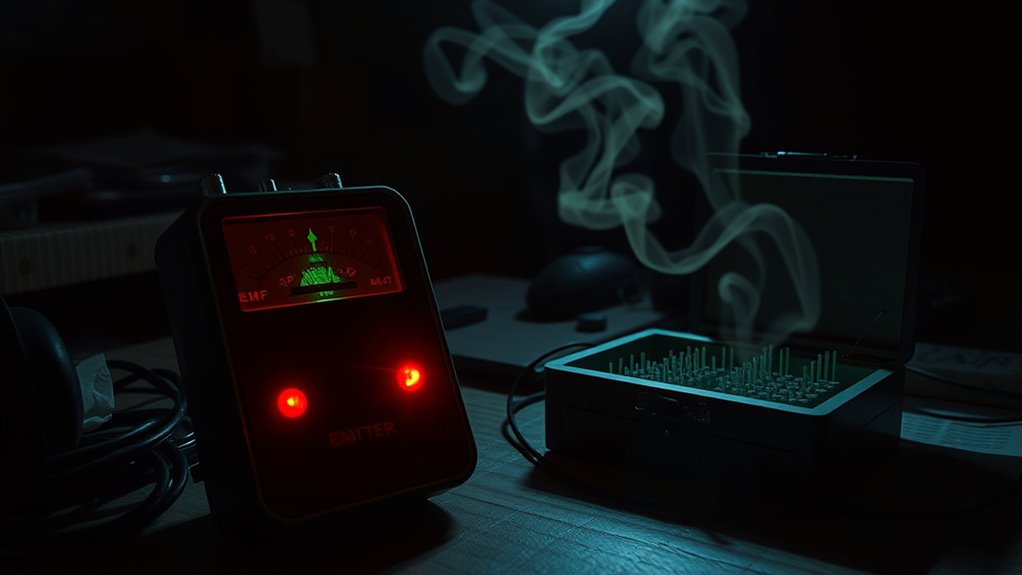
EMF meters are handheld devices designed to measure electromagnetic fields in the environment. Based on electromagnetic theory, these devices detect fluctuations in electromagnetic energy, which some claim indicate paranormal activity. However, their effectiveness depends heavily on proper device calibration; if not calibrated correctly, readings can be inaccurate. Proponents believe that sudden spikes in electromagnetic fields may signal spirits’ presence, but scientifically, these variations often result from everyday electrical devices or environmental factors. EMF meters don’t specifically detect spirits; instead, they measure electromagnetic interference. Understanding how electromagnetic fields work and ensuring the device is correctly calibrated is essential for any meaningful reading. Proper calibration involves adjusting the device according to manufacturer instructions and environmental conditions, which is crucial for accurate measurements. Without proper calibration, users risk misinterpreting normal environmental signals as paranormal phenomena. Additionally, high-quality calibration is crucial for obtaining reliable and consistent measurements.
The Mechanics Behind Spirit Boxes and Their Method of Communication
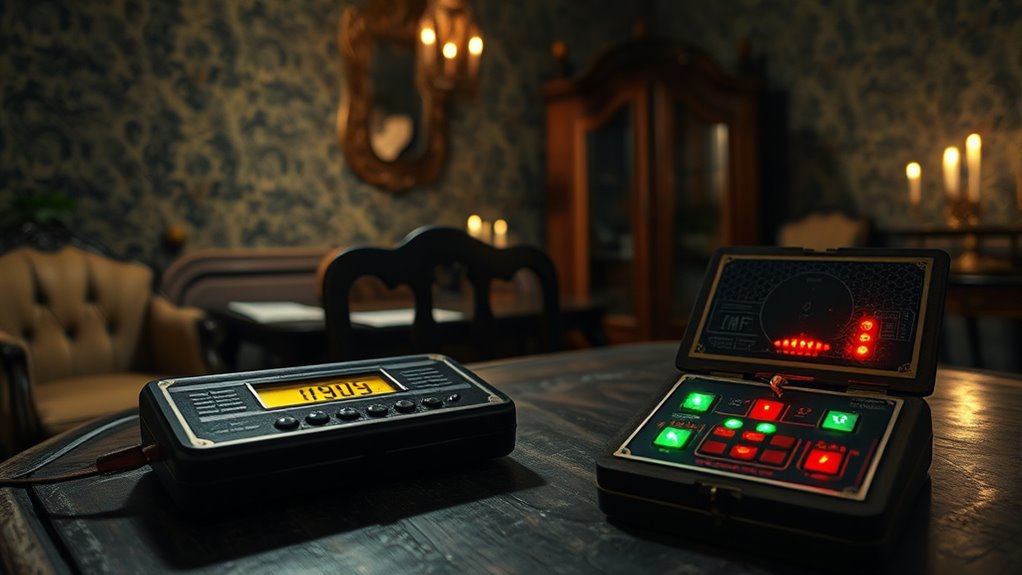
Spirit boxes are electronic devices that scan radio frequencies rapidly, creating a continuous stream of noise and snippets of broadcast signals. They work by sweeping through various frequencies, which can produce random words or phrases that some interpret as messages from spirits. However, equipment limitations mean that the sounds are often just random radio snippets, not meaningful communication. User biases also play a role; when you listen, you tend to hear words that fit your expectations or thoughts, a phenomenon known as pareidolia. This means that what you perceive as spirit messages may simply be your mind making sense of the noise. The mechanics rely heavily on chance and perception, making it unlikely that spirit boxes facilitate genuine communication. Additionally, scientific research shows that sound vibrations can influence brainwave patterns, which may contribute to the perception of meaningful messages during these sessions. Moreover, the financial investment in such devices is often substantial, yet their effectiveness remains scientifically unproven. The power of perception bias can lead users to interpret ambiguous sounds as clear evidence of spirits. Understanding the role of psychological factors helps clarify why users often interpret random sounds as meaningful communications.
Scientific Explanations for EMF Fluctuations in Haunted Locations

You might notice EMF fluctuations in supposedly haunted places, but natural sources like electrical wiring and appliances often cause these changes. Environmental factors such as weather conditions and metal structures can also interfere with electromagnetic readings. Understanding these natural and environmental influences helps explain EMF spikes without invoking spirits.
Natural EMF Sources
Many of the electromagnetic field fluctuations reported in supposedly haunted locations can be explained by natural sources rather than supernatural activity. Natural emf comes from everyday sources like electrical wiring, appliances, and plumbing that generate electromagnetic interference. These can cause fluctuations that mimic the signals paranormal investigators seek. For example, a faulty light switch or aging wiring can produce inconsistent readings on EMF meters. Environmental factors such as weather changes or underground minerals may also contribute to natural emf variations. Recognizing these natural sources helps you understand that not all EMF fluctuations indicate spirits or paranormal activity. Instead, they often result from common, explainable phenomena, making it essential to consider these natural emf sources before jumping to supernatural conclusions. Additionally, automation technologies are increasingly used to monitor and analyze environmental electromagnetic data, helping to distinguish between natural and unnatural emf fluctuations.
Environmental Interference Factors
Environmental factors can considerably influence electromagnetic field readings in supposedly haunted locations. Electromagnetic interference from nearby electronic devices, power lines, or wireless signals can cause fluctuations that mimic paranormal activity. Environmental noise, such as radio waves or static, can also distort EMF readings, making it seem like there’s a supernatural presence when there’s actually a natural cause. Even lighting conditions, temperature changes, or the building’s wiring can contribute to irregular readings. These external influences create false positives, leading people to believe in ghostly activity when, in reality, electromagnetic interference is at play. Understanding these environmental interference factors helps demystify EMF fluctuations and underscores the importance of considering natural sources before jumping to paranormal conclusions.
Analyzing the Accuracy of Spirit Box Transmissions

When evaluating spirit box transmissions, you’ll notice concerns about how clear the messages actually are, especially amid background noise. Analyzing language patterns can reveal whether responses seem intentional or just random echoes, while interference from static or other sounds often muddles the message. These factors make it difficult to determine if the transmissions are genuinely meaningful or just coincidental noise. Additionally, understanding the use of a curling iron on Halloween wigs can help distinguish authentic paranormal tools from misused devices that may produce misleading signals. Recognizing the limitations of EMF meters in detecting paranormal activity can further clarify whether these gadgets are reliable indicators or simply influenced by environmental factors.
Transmission Clarity Concerns
The accuracy of spirit box transmissions has long been a subject of skepticism, as the clarity and reliability of the messages often come into question. Electromagnetic interference from nearby electronics can distort signals, making it hard to determine if the responses are genuine or random noise. Additionally, improper device calibration can lead to inconsistent results, further undermining confidence in the data. When your spirit box isn’t properly calibrated, it may produce garbled sounds or false positives, giving the illusion of communication where there’s none. This lack of standardization and susceptibility to interference casts doubt on the legitimacy of transmitted messages. Without strict controls over interference and calibration, you can’t reliably trust the clarity or accuracy of spirit box outputs.
Language Pattern Analysis
Analyzing the language patterns of spirit box transmissions reveals significant issues with their accuracy and consistency. Using machine learning, researchers attempt to detect meaningful patterns, but results often fall short. You might notice vague words, random phrases, or repeated sounds that lack logical connection. Glycolic acid products, which are commonly used in skincare routines, do not influence the reliability of spirit communication. Words that seem to drift in and out, like echoes of a forgotten conversation, demonstrate a lack of structured communication. Phrases that are incomplete or oddly structured, making no clear sense, further highlight the randomness present in the data. Sudden shifts in language, disrupting any narrative flow, suggest a lack of coherent message. Overlaps of unrelated words, creating confusion, are common and undermine the credibility of the transmissions. Transmissions that mimic common speech patterns without genuine context emphasize the absence of authentic dialogue. These inconsistencies highlight how unreliable pattern recognition is within spirit box data. When examining linguistic analysis, it becomes clear that many transmissions are more noise than communication, challenging claims of authentic spirit communication. By examining language patterns critically, you see that many transmissions are more noise than communication, challenging claims of authentic spirit communication.
Random Noise Interference
Random noise interference plays a significant role in undermining the accuracy of spirit box transmissions. When you use a spirit box, it scans radio frequencies rapidly, but electromagnetic interference from nearby electronics or power sources can distort signals. These disruptions create random noise that makes it difficult to distinguish genuine responses from static or interference. Radio frequency congestion also causes overlapping sounds, leading you to hear words or phrases that aren’t intentionally transmitted. This interference can give the illusion of communication with spirits when, in reality, it’s just background noise. Without proper filtering or control of electromagnetic interference, the reliability of spirit box responses remains questionable. Recognizing the impact of random noise helps you understand why many spirit box sessions produce inconsistent or ambiguous results. Additionally, the use of eye patches for skin care demonstrates how external factors like ingredients and application timing can influence effectiveness and results.
Common Misconceptions and Myths About Ghost Gadgets

Many people believe ghost gadgets can detect spirits or paranormal activity with little scientific backing, but these claims are often based on misconceptions and myths. This is where paranormal skepticism comes into play, questioning the gadget validity of devices like EMF meters and spirit boxes. You might imagine:
- Spirits communicating through random static
- EMF fluctuations signaling ghostly presence
- Spirit boxes capturing clear, intelligible messages
- Gadgets working reliably in every haunted location
- Devices detecting paranormal activity without error
In reality, these beliefs overlook the lack of scientific evidence supporting such claims. Most ghost gadgets are prone to false positives and interference. Understanding these misconceptions helps you approach paranormal tools with a critical eye, recognizing their limitations rather than accepting exaggerated claims. Additionally, Hydrotherapy shows how water’s physical properties are used in health practices, contrasting with the often unproven claims of ghost detection devices. Moreover, the lack of scientific validation emphasizes the importance of skepticism when evaluating paranormal gadgets. Recognizing the breed-specific traits of these devices can help distinguish between genuine technology and pseudoscience.
Real Evidence vs. Hoaxes and Misinterpretations

While some claims of paranormal evidence rely on genuine phenomena, many so-called “proofs” are hoaxes or misinterpretations. Paranormal skepticism helps you question the validity of these claims, revealing how easily gadgets like EMF meters or spirit boxes can produce false positives. Limitations in these devices mean they often pick up background electromagnetic interference or random static, which can be mistaken for paranormal activity. People may also interpret ambiguous readings as spirits, but without scientific validation, it’s hard to distinguish real evidence from coincidence. You should be cautious about accepting every paranormal “proof” at face value. Recognizing gadget limitations and applying skepticism is vital to separating genuine phenomena from deceptive illusions or simple errors in interpretation.
The Role of Psychology and Expectation in Paranormal Readings
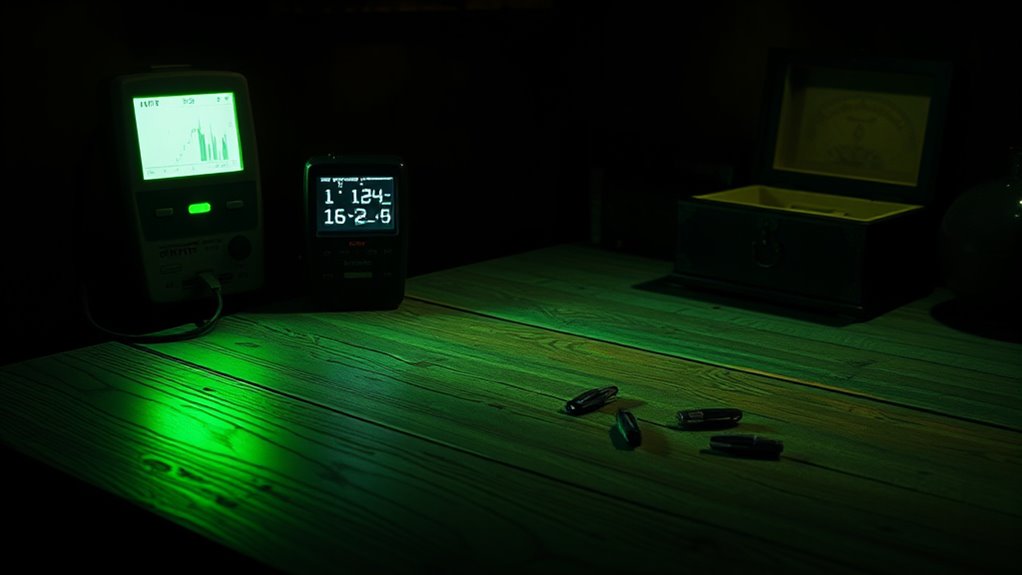
Your expectations and beliefs can remarkably influence how you interpret paranormal readings. Cognitive bias and expectation effects shape your perception, making you more likely to see what you want or fear to see. When using EMF meters or spirit boxes, your mind may fill in gaps, creating a ghostly image from vague data.
Your beliefs can distort paranormal readings, causing you to see what you hope or fear to find.
Imagine:
- Hearing voices that confirm your hopes or fears
- Feeling a chill when expecting a spirit encounter
- Interpreting random electrical interference as supernatural activity
- Seeing shapes or figures in static noise
- Believing in responses because you’re primed to find them
These biases show how your mind can deceive you, highlighting the power of psychology over perceived paranormal evidence. Expectation effects can turn neutral signals into “proof,” even when no paranormal activity exists.
Expert Opinions and Scientific Studies on Paranormal Devices

Scientific studies and expert opinions consistently indicate that paranormal devices like EMF meters and spirit boxes lack reliable evidence to support their claims. Many scientists and skeptics argue that these gadgets are limited by device constraints and natural environmental influences, which can produce false positives. Paranormal skepticism remains strong because these devices often respond to harmless electromagnetic interference or random noise, not supernatural activity. Researchers highlight that the device limitations—such as sensitivity to nearby electrical sources—make it easy to misinterpret readings. Without rigorous scientific validation, these tools fall short of credible evidence for paranormal phenomena. Ultimately, expert opinions emphasize that relying on such devices without scientific backing can lead to misconceptions, reinforcing the need for skepticism and critical evaluation of paranormal claims.
Alternative Approaches to Investigating Paranormal Activity

When investigating paranormal activity, many researchers turn to methods beyond standard electronic devices, focusing instead on alternative approaches that emphasize personal experience and contextual evidence. These methods often appeal to paranormal skepticism, questioning the gadget reliability of high-tech tools like EMF meters. Instead, you might rely on your senses, intuition, or the environment itself to gather clues. For example, you could:
- Record EVP sessions to catch unexplainable sounds
- Observe environmental changes like temperature drops
- Track unexplained shadows or movements
- Use mirror gazing or scrying for visual impressions
- Document emotional or psychological responses during investigations
These techniques prioritize subjective perception over questionable device readings, fostering a more grounded and personal approach to understanding paranormal activity without over-relying on potentially unreliable gadgets.
Frequently Asked Questions
Can EMF Meters Differentiate Between Natural and Supernatural Energy Sources?
You might wonder if EMF meters can perform electromagnetic differentiation between natural and supernatural energy sources. In reality, these devices measure electromagnetic fields without distinguishing their origins. While they detect fluctuations, they can’t reliably tell natural energy from supernatural, since both can produce similar readings. So, don’t rely solely on EMF meters for identifying supernatural activity; their readings need interpretation within a broader context.
Are Spirit Boxes Capable of Genuine Communication With Spirits or Just Random Noise?
You might think spirit boxes are channels to the spiritual domain, but their mechanics rely on rapid sound scans and radio interference, creating random noise. Paranormal communication theories suggest they could pick up spirits, but most experts agree it’s just chance and human interpretation. You’ll find that what seems like a message is often just coincidence, making spirit boxes unreliable tools for genuine communication with spirits.
How Do Environmental Factors Influence EMF Readings During Paranormal Investigations?
Environmental factors considerably influence EMF readings during paranormal investigations. You need to watch out for electrical interference from devices like phones, lights, or wiring, which can produce false readings. Natural electromagnetic sources such as storms or underground minerals also skew results. By controlling these variables and understanding their effects, you can better distinguish genuine paranormal signals from everyday natural or electrical noise.
What Are the Limitations of Current Scientific Methods in Verifying Ghost Gadget Claims?
When questioning the quality of quick, questionable claims, you confront critical constraints. Technological constraints limit tools’ precision, while interpretative biases distort data, making validation difficult. Scientific methods struggle to substantiate ghost gadget claims because they rely on subjective interpretation, not definitive proof. You must recognize these limitations, understanding that current technology and biases hinder objective verification, leaving paranormal possibilities open but unproven by mainstream science.
Do Cultural Beliefs Affect the Interpretation of Readings From Ghost Detection Devices?
Cultural perceptions and belief influence greatly affect how you interpret readings from ghost detection devices. If you hold strong supernatural beliefs, you’re more likely to see anomalies as spirits, while skeptics may dismiss similar readings as electrical interference. Your cultural background shapes your expectations and perceptions, leading you to interpret the data through a lens of belief or disbelief, which profoundly impacts the perceived validity of the device’s readings.
Conclusion
While ghost gadgets like EMF meters and spirit boxes might seem promising, they often lead you down the garden path. The truth is, many of these devices are more about perception than proof. Remember, just because something shines doesn’t mean it’s gold. Stay skeptical and don’t let your hopes be dashed by illusions. Sometimes, the best way to see the truth is to look beyond the surface and trust what you can truly verify.




